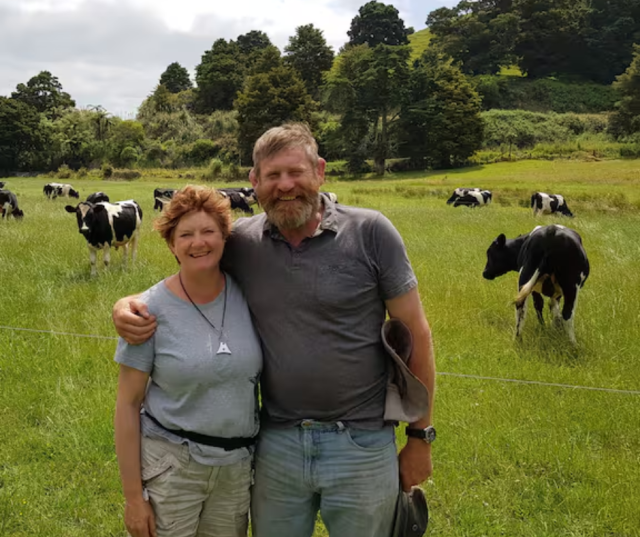This Earth Day, celebrated globally on 22 April, Beef + Lamb New Zealand (B+LNZ) is highlighting some of the fantastic work farmers are doing to protect and enhance our environment.

New Zealand's sheep and beef sector has reduced its absolute greenhouse gas emissions by 30% since 1990, our sheepmeat and beef has among the world’s lowest carbon footprints and our farmers protect 24% of New Zealand’s total native vegetation – and that’s just to name a few achievements.
All of this is possible thanks to ongoing work farmers are doing, and the changes they are making (big or small), to improve their systems.
Take for example, Bill and Pam McCall, who farm 420 hectares (400 effective) with around 4,500 stock units – a mix between sheep and beef – in Waikoikoi, West Otago.
The McCalls are working hard to enhance and protect their farm’s natural environment. They recently put 7 hectares of swamp into the QE11 Trust, are fencing off all waterways - targeting the slow-moving parts first to decrease sediment loss - and have improved their winter grazing practices.
Future-proofing their family farm is important to them. They have recently brought their son Gareth and partner Thea into the partnership.
Bill says, “Farmers are doing a lot of great work and there has been a lot of step-changes made to the benefit of our environment that we can be really proud of. It is important to celebrate the ‘little wins’ we have on our journey as guardians of our land and environment.
“From my conversations with farmers, I get a real sense that everyone is chipping in and trying to do their bit.”
Bill is Chair of B+LNZ’s Environment Reference Group (ERG), a valuable advisory group made up of 14 farmers from across B+LNZ’s eight Farmer Councils. The group provides a sounding board for farmer input and feedback into B+LNZ’s environmental policy and advocacy work.
He says the B+LNZ ERG is an important part of B+LNZ’s policy process to ensure B+LNZ’s advocacy efforts lead to workable solutions for farmers.
“We meet with B+LNZ’s policy team, nut out key issues, listen to what they are thinking in terms of solutions and discuss whether the policy would be workable on our own farms. Since we’re scattered across the country and have a wide range of farming systems, we provide a good mix of perspectives and input.
“I really enjoy being a part of this group. It’s a fantastic network of like-minded people who all have the environment top of mind. They are all focused on improving our environment, our farms, our land with the next generation in mind,” says Bill.
Jeff Martin, Northland farmer and member of B+LNZ’s Northern North Island Farmer Council and ERG says he enjoys learning from everyone involved in the group.
“We get to hear from specialist speakers who dive into the detail of their topic areas, we learn from B+LNZ’s Environment team about what’s on the horizon and how they are collaborating with others to work on solutions, and we learn a lot from each other about our region-specific issues.
“The collegial atmosphere of ERG is great, there is an electricity that comes from the passion of the members. It’s different from other groups, it is an inquisitive group whose role is to share information as well as question it.
“I have been on the ERG since 2018 and feel privileged to have met many highly intelligent farmers that are deeply committed to both New Zealand's environment and to a thriving New Zealand sheep and beef sector.
“Outside of ERG, both my wife Helen and I are proud to be Ballance Farm Environment Award judges following our Northland win in 2020,” adds Jeff.
Jeff and wife Helen's 450 hectares (250 effective) farm is at the head of the Wainui stream in the Otangaroa Valley in Kaeo, Northland.
“We have always been acutely aware how much impact we could have on the catchment downstream from us, so we only stock Rising 1-year-old cattle and have extensive riparian stock exclusion, regardless of slope or size of the waterway.
“We’re proud to say our waterways are in pristine condition and I have spotted golden longfin eels twice, an extremely rare fish that only exists in the cleanest of waterways.
“Our land is surrounded by predominately heavy indigenous forest, with a good possum ,stoat and rat control programme. There are no deer or feral goats, so our bush is sequestering plenty of carbon as it continues to grow.
“We keep our carbon emissions to a minimum by farming bulls, have reduced stock numbers by 22% in the last 3 years and have retired the highly erodible land and planted pines and poplars. We have a good mixture of indigenous vegetation, wetlands, streams, rivers and riparian areas, and exotic forestry,” he says.
